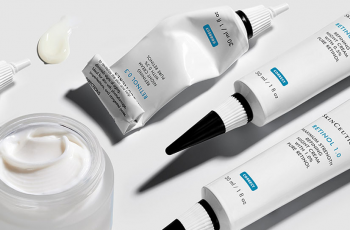
Can You Mix Tretinoin with Azelaic Acid Together?
Tretinoin and azelaic acid are two popular skincare ingredients known for their ability to treat acne and other skin imperfections.
Both ingredients share common ground in that they are powerful exfoliators, improving the skin’s texture and clarity by sloughing away dead skin cells.
They also tackle issues like hyperpigmentation, dark spots, and overall skin tone unevenness.
But, can you use these two ingredients together in your skincare routine without causing harm to your skin? That’s exactly what we’ll explore today.
If you’re already familiar with the benefits of these two powerful ingredients, feel free to skip ahead to the part where we explain how to mix them properly.
If you’re new to tretinoin and azelaic acid, no worries—we’ll start by breaking down what each one is and how they benefit the skin.
What Is Azelaic Acid?
Azelaic acid is often mistaken as a member of the AHA or BHA families, but it’s actually its own unique acid.
Derived from grains like barley and wheat, azelaic acid naturally occurs in the skin and is known for its anti-inflammatory and antibacterial properties.
This makes it an excellent choice for individuals with sensitive skin or those prone to redness and swelling.
Azelaic acid works by targeting acne-causing bacteria and calming irritated skin. It also helps to lighten dark spots and hyperpigmentation, leading to a more even complexion.
Beyond its acne-fighting benefits, azelaic acid also reduces the appearance of fine lines and wrinkles, giving the skin a smoother, more youthful appearance.
If you’d like to learn more about the benefits of azelaic acid, feel free to check out our dedicated blog post that dives deeper into how this ingredient works.
What Is Tretinoin?
Tretinoin is a prescription-strength retinoid, a more potent form of retinol (Vitamin A).
Retinol and retinoids both belong to the same family of ingredients, but tretinoin is stronger and usually prescribed for severe acne or signs of aging like wrinkles and fine lines.
Tretinoin works by increasing skin cell turnover, which means it speeds up the process of shedding dead skin cells and replacing them with new ones.
This not only helps with acne but also improves skin texture, brightness, and elasticity. Since tretinoin is a powerful ingredient, it’s important to use it with care.
It’s typically used in the evening because it can increase your skin’s sensitivity to UV light, making it more prone to sun damage.
If you’re new to tretinoin, it’s essential to follow your healthcare provider’s instructions for safe and effective use. Don’t skip out on sunscreen during the day to protect your skin from UV damage.
For a more in-depth look at how tretinoin works and how to incorporate it into your routine, check out our blog post on this powerhouse ingredient.
Can You Mix Tretinoin with Azelaic Acid?
Now that we understand what each ingredient does, let’s answer the burning question: Can you mix tretinoin with azelaic acid?
Yes, you can use these two ingredients together, but there are some important guidelines you should follow to ensure your skin stays healthy and irritation-free.
Both tretinoin and azelaic acid have exfoliating properties, but they work in slightly different ways.
Tretinoin works by increasing skin cell turnover, while azelaic acid targets the bacteria that contribute to acne.
These two ingredients don’t directly interfere with one another, so you can use them in the same skincare routine if done correctly.
How to Mix Tretinoin with Azelaic Acid?
The key to successfully using tretinoin and azelaic acid together lies in the order and frequency of application. Here’s the general approach:
1. Start Slowly:
If you’re new to both tretinoin and azelaic acid, it’s crucial to ease into your routine to avoid irritation. Both of these ingredients can cause dryness or irritation, especially when used in higher concentrations.
Start with a gentle azelaic acid cleanser or face wash that contains lower percentages of the acid.
These formulas are usually less harsh because they are rinsed off the skin. Gradually build your skin’s tolerance over the course of 3 weeks.
2. Layer from Thinnest to Thickest:
As a general rule, when layering skincare products, you should always apply them from the thinnest to the thickest consistency.
So, if you’re using a serum with tretinoin and a gel-like product with azelaic acid, start with the tretinoin and then follow with azelaic acid. This allows each product to absorb effectively.
3. Give Time Between Applications:
If you’re using both tretinoin and azelaic acid in your routine, it’s a good idea to wait about 15-20 minutes between applying each product.
This gives your skin time to rebalance its pH levels, which helps avoid irritation or sensitivity.
4. Start Using Tretinoin in Your Evening Routine:
Tretinoin is best used at night, as it makes your skin more sensitive to sunlight.
Always apply it as directed by your doctor, and make sure to wear sunscreen with an SPF of at least 30 during the day to protect your skin.
Applying it in the evening allows the ingredient to work overnight while you sleep, boosting skin regeneration.
Can I Use Azelaic Acid and Retinol (Tretinoin) Together?
Yes, azelaic acid and retinol (including tretinoin) can be used together—but there’s a caveat.
Both ingredients can be quite potent, so it’s essential to apply them correctly to minimize irritation.
Here are a few tips to make it work:
Wait 15 Minutes: After applying one ingredient, wait about 15 minutes before applying the other. This gives your skin time to adjust and reduces the likelihood of irritation.
Alternating Days: If you find that using both tretinoin and azelaic acid on the same night is too harsh, you can alternate days.
Use azelaic acid during your morning routine (always follow up with SPF) and tretinoin in your evening routine. This gives your skin a break between applications.
Use Azelaic Acid in the AM: Azelaic acid is a gentle exfoliant, making it safe for daytime use.
Since tretinoin is best used at night, this gives you the flexibility to use both without overloading your skin.
Is Azelaic Acid Better Than Tretinoin?
Both azelaic acid and tretinoin are effective ingredients, but they work in different ways, so which one is “better” depends on your skin’s needs.
Tretinoin is stronger and more potent, making it a great choice for treating severe acne and signs of aging like wrinkles and fine lines.
It works by increasing cell turnover and can provide rapid results.
Azelaic Acid, on the other hand, is generally gentler on the skin.
It’s excellent for those with sensitive skin or individuals who struggle with redness or inflammation. It’s also effective for treating mild acne and pigmentation concerns like dark spots.
In terms of strength, 20% azelaic acid is roughly equivalent to 0.05% tretinoin. However, azelaic acid tends to be better tolerated, especially by those with sensitive skin.
What Should You Avoid Using With Azelaic Acid?
While azelaic acid is relatively gentle, there are some ingredients you should avoid using alongside it to prevent irritation or dryness:
Salicylic Acid and BHAs: Combining azelaic acid with salicylic acid or other beta hydroxy acids (BHAs) can increase the risk of skin dryness and irritation.
AHAs: Alpha hydroxy acids like glycolic acid, lactic acid, or mandelic acid should also be avoided when using azelaic acid, as they can lead to excessive exfoliation, making your skin more vulnerable.
How Long Does Azelaic Acid Purging Last?
When introducing azelaic acid to your skincare routine, you might experience a “purging” phase. This happens when the increased skin cell turnover brings underlying blemishes to the surface.
Purging typically lasts anywhere from 3 weeks to 5 weeks. If the purging continues beyond 6 to 8 weeks without improvement, it may be time to consult a dermatologist.
Final Thoughts on Mixing Tretinoin with Azelaic Acid
You can safely use tretinoin and azelaic acid together, but it’s important to be mindful of how you layer and apply these ingredients.
Start slowly, give your skin time to adjust, and always follow up with a good sunscreen.
If you experience irritation or dryness, consider adjusting your routine to alternate between these ingredients on different days or times of day.
As with any skincare routine, consistency is key.
With the right approach, these two powerhouse ingredients can help you achieve clearer, more even skin while reducing the appearance of acne and hyperpigmentation.
If you have any more questions or need personalized advice, feel free to follow us on Instagram for more skincare tips!

